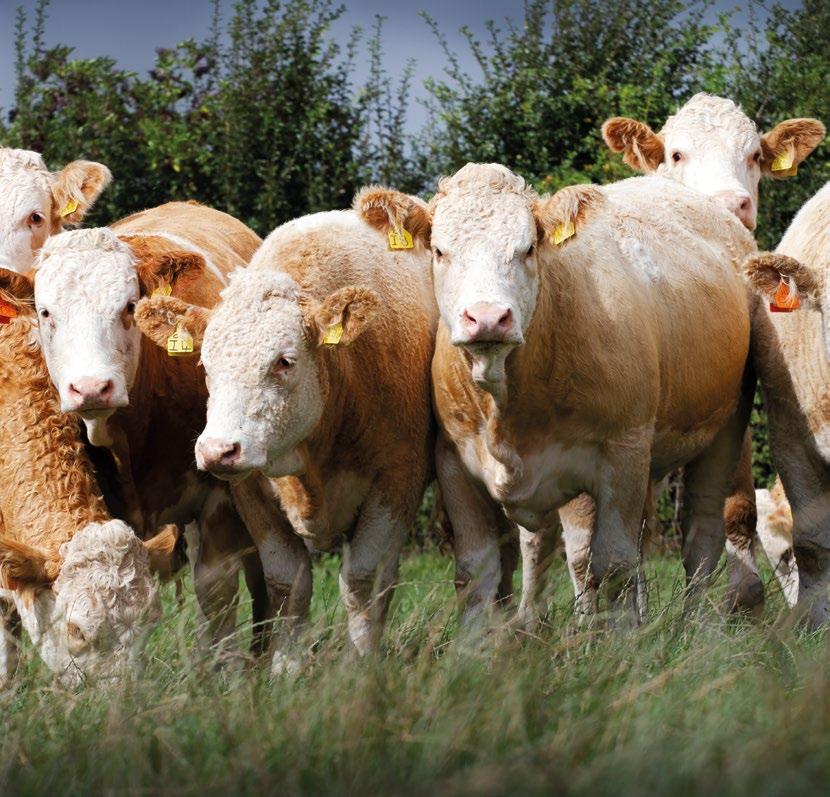
5 minute read
Bowley Herd Feature
EASY MANAGED, CONSISTENT SIMMENTALS TICKING ALL THE BOXES
FOR THE BOWLEY HERD
Advertisement
As a British Simmental herd that typically registers 150-200 calves per year, the most in England, we take a look at what’s behind the management ethos of the Bowley Herd of Mr CM Mercer, based at Hope-Under-Dinmore, Herefordshire.
Having worked with various breeds of cattle in his career, stock manager at Bowley Court Farm, Richard Bell, says the Simmental has stood the test of time for the breed’s superior mothering ability, calving ease and temperament.
Richard, who manages the 300-cow herd across the 550-acre grass farm alongside stockman Andrew Bennett on behalf of owner C M Mercer, has been with the herd for some 42 years and has witnessed various attributes of many breeds, but feels the Simmental breed delivers on all areas of suckler beef production.
“We’ve tried all manner of breeds in the past, have witnessed some of the benefits of hybrid vigour too, but overall nothing has really delivered as consistently and with the ability to tick all the boxes as well as the Simmental,” highlights Richard.

The herd consists of pedigree and purebred Simmental cattle and finishes progeny for ABP with recent sales of 12-13 month old bulls topping at £1550 with 90% hitting U grades and the remaining 10% hitting R grades. “While the Simmental is highly regarded as a maternal breed, these grades are testament to the fact that the breed can hold its own with any of the Continental breeds when it comes to quality beef production.”
Meanwhile, some 55 heifers are retained each year with the remainder being sold locally as 14/15-month old stores, often to repeat customers.
With just two staff working the herd, Richard says ease of management is key. “The herd starts calving indoors around the 20th March and finishes at the end of June with calves tagged, dehorned and then turned out for spring grazing,” he explains.
In the run up to calving, cows are fed 2-3lb of cake as well as fodder beet a day according to their condition, alongside wheat or barley straw until calving. Upon turnout, twins are separated with those calves receiving concentrate all through the summer. “With Simmentals we often get twins and we see about 10%, but due to milk availability the dams are quite capable of rearing them,” he adds.




from For Farmers alongside grass silage, while heifers are fed approximately 6lb of blend alongside grass silage.
Currently the herd runs a total of 13 stock bulls, of which 10 have come from Society sales at Worcester or in the past Bristol and Welshpool, with two being purchased privately and one being homebred. “We usually do a range of semen testing prior to use and we tend to test the oldest, youngest and newest in the stock bull team,” explains Andrew Bennett, who has been working with the herd for the last two years.
“Historically, bulls have been purchased from the Wroxall, Heywood, Killiworgie and Bosahan herds and the late David Bell. Proving the test of time for some years, the herd’s first bull was purchased for 1000gns at the very first Society sale in Hereford Market in the form of Lindridge Keefe,” adds Richard. “We’re now looking at sourcing polled bulls which will no doubt help reduce labour needs going forward, providing we can keep the strong fleshing ability on the bulls,” he adds. With the exception of stock bulls, the herd has remained closed to females for some years.
When looking for bulls, Richard and Andrew take both figures and physical presence into consideration, but with the biggest emphasis being on calving ease. “We’re conscious some bulls are pushed hard for sale, so we’re looking for natural fleshing, good legged bulls that aren’t too heavy in the front as well as looking at their calving figures.”
Longevity is another key attribute of the Simmental breed and Richard says even the stock bulls last, with one of them still working at 12 years of age. “But while longevity is key, we are strict on culling with any cow showing temperament issues going, as well as bad feet

and udders and with cull cow price hitting up to £1400 recently, it’s worth keeping a close eye on physical attributes.”
Heifers calve at two years of age at the same time as the mature herd. “We prefer to run them as a separate bunch for the first year before joining the main herd,” adds Andrew.
Cows are routinely vaccinated for BVD, Leptospirosis, Rotavec and Rispoval 4, as well as a preventative vaccine for clostridial disease as they once lost a cow to Blackleg. “We prefer to wean during the last two weeks of October and if grazing allows, cows go back out to grass to dry up until housing at the end of November.”
Richard admits grazing management is minimum as most of the fields are too steep to plough and many of the lower fields are subject to flooding. “The farm is host to an anaerobic digester with a small amount of arable to help with rotation. Muck from the cattle goes into the digester and the digestate is put back on to the land.
“Simmentals tick so many boxes for us, allowing us to run a closed herd, minimising the health risks associated with bought in replacements, as well as producing high value surplus females for sale alongside prime bulls which achieve good grades too. It would take a lot for us to consider an alternative breed,” Richard concludes.










